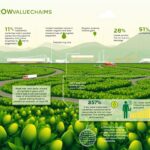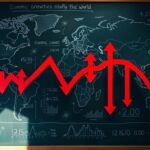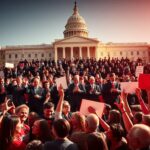The U.S. economy is facing a big slowdown. Experts predict a drop in GDP growth from 3% to 1.3% by 2025. This change is not just for the U.S., as the International Monetary Fund (IMF) has also cut its global growth forecast to 2.8% from 3.3%.
The slowdown in the U.S. economy will have big effects, not just in the U.S. but around the world. As the biggest economy, any decline in its growth can affect trade, investment, and stability everywhere.
Key Takeaways
- The U.S. GDP growth is predicted to slow down significantly by 2025.
- The IMF has revised its global economic growth forecast downwards.
- A decline in U.S. economic growth can have global economic implications.
- The slowdown is expected to affect trade and investment.
- Economic stability worldwide may be influenced by the U.S. economic performance.
The Current State of the U.S. Economy
The U.S. economy is facing a mix of growth and decline. It’s important for investors, policymakers, and the public to understand this. The recent GDP performance and key growth drivers show the economy’s direction.
Recent GDP Performance and Growth Trends
The U.S. GDP growth has slowed down, dropping from 3% to 1.3%. This slowdown is due to global trends and domestic policy changes. The euro area is also seeing slow growth, with 2024 expected to be another slow year.
In the first three quarters of 2024, the U.S. economy has shown mixed results. The GDP growth rate has been influenced by consumer spending, business investment, and government spending. The economy is facing challenges from trade tensions and policy uncertainty.
Key Growth Drivers in Recent Quarters
Consumer spending and business investment have been the main growth drivers. But, the decline in net exports and government spending has affected growth. Analysts and policymakers closely watch the economy to understand trends and make decisions.
U.S. Economic Slowdown 2025: Forecasts and Projections
As we approach 2025, the U.S. economy is expected to slow down. This slowdown is forecasted by major economic institutions like the Federal Reserve, IMF, and World Bank. They have lowered their growth predictions, hinting at an economic slowdown.
Major Economic Institutions’ Growth Predictions
Forecasts from top economic groups show a big slowdown in U.S. growth. The IMF predicts the U.S. economy will grow 1.8% this year, down from 2.7% before. This change shows a loss of growth speed.
Federal Reserve Economic Outlook
The Federal Reserve’s outlook is key in setting market expectations. The Fed might lower interest rates to help slow down the economy.
IMF and World Bank Projections
The IMF and World Bank also see growth rates falling. Their forecasts, like others, suggest a global economic slowdown. These changes in growth predictions show big challenges for the U.S. economy in 2025.
In summary, forecasts for 2025 show a big slowdown in U.S. economic growth. The IMF, Federal Reserve, and World Bank’s lowered growth predictions highlight the challenges ahead.
Historical Context: Previous Growth Cycles and Slowdowns
It’s important to know about past economic growth cycles to understand today’s slowdown in the U.S. economy. The U.S. has seen ups and downs, each caused by different things.
Post-Pandemic Recovery Patterns
The recovery after the pandemic has shown unique patterns. The euro area’s private spending recovery was slower and started later than hoped. This slow start affects the overall economy’s growth.
2021-2023 Growth Acceleration Factors
Several things helped the economy grow faster from 2021 to 2023. Fiscal stimulus packages and a rise in consumer spending were key. These helped the economy bounce back after the pandemic.
Signs of Recovery Plateau
Even with initial growth, signs suggest the recovery might be leveling off. Economic indicators like GDP growth and consumer spending have slowed down. This could mean the recovery is hitting a plateau.
Looking at past growth cycles and slowdowns helps us understand today’s U.S. economy. By studying the post-pandemic recovery and what drove growth, we can see why the recovery might be slowing down.
Policy Uncertainty and Its Impact on Growth
As the U.S. approaches 2025, policy uncertainty is becoming a big deal for economic growth. The upcoming election adds a layer of unpredictability. This affects business investment and consumer confidence.
Companies might hold back on investments and growth due to policy uncertainty. They wait to see how trade policies and other economic measures will unfold. This cautious approach can slow down economic growth as businesses delay or cancel plans.
Election Year Economic Policies
Election years often bring big policy changes. The current administration might propose new economic policies or revisit old ones to win votes. These changes can make the market uncertain, affecting investor mood and business decisions.
Policy uncertainty can hit hard in areas like trade policies, fiscal spending, and regulatory changes. For example, changes in trade agreements or tariffs can directly affect businesses that trade internationally.
Fiscal Policy Proposals and Market Reactions
Fiscal policy proposals in an election year can cause big market reactions. Investors watch closely for plans on infrastructure spending, tax changes, or social program adjustments. The anticipation or announcement of these policies can lead to stock market, bond yield, and currency value changes.
Key market reactions include:
- Stock market volatility due to uncertainty about future earnings and corporate tax rates
- Bond market movements influenced by expectations of future interest rates and government borrowing
- Currency fluctuations based on trade policy changes and their impact on trade balances
Legislative Gridlock Effects
Legislative gridlock, often worse during election years, can make policy uncertainty worse. When the government is divided or election-year politics leads to stalemate, important economic policies may be delayed or blocked. This gridlock can make it hard for the government to tackle economic challenges effectively.
The resulting uncertainty can have far-reaching effects on business confidence and investment decisions, potentially slowing down economic growth.

Trade Tensions and Tariff-Driven Slowdown
The ongoing trade tensions have led to a tariff-driven slowdown in the U.S. economy. New tariffs have hurt international trade and also affected domestic economic activities.
Recent data shows the global economy is slowing down. The IMF has lowered its growth forecasts. It now expects China to grow 4% this year and next, down roughly half a point from its previous forecasts.
Impact of New Tariff Policies
New tariff policies have been a big factor in the economic slowdown. These policies have raised costs for businesses and consumers, impacting overall economic growth.
U.S.-China Trade Relations
The trade tensions between the U.S. and China have been very impactful. The ongoing U.S.-China trade relations issues have led to a decline in trade between the two nations. This affects global supply chains.
Effects on Domestic Manufacturing Costs
The tariffs on imported goods have increased domestic manufacturing costs. This increase in costs has been passed on to consumers. It has led to higher prices and reduced demand.
The combined effect of these factors has slowed down economic growth. The U.S. economy has been hit hard due to its significant trade relationships with countries like China.
Consumer Spending Contraction: Causes and Effects
## Consumer Spending Contraction: Causes and Effects
The U.S. economy is slowing down in consumer spending, a key driver of growth. Household debt is rising, with credit card balances up 14% in Q4 2024. This is a worrying sign for household finances.
Several factors are causing this slowdown. Rising debt and falling savings rates are major contributors. As debt grows, spending power decreases, leading to less consumer spending. This affects many parts of the economy.
### Household Debt and Savings Rates
Household debt keeps going up, mainly due to more credit card and student loan debt. This means more money goes towards paying off debt. Savings rates are falling, leaving less financial safety for households.
#### Credit Card and Student Loan Debt Burden
Credit card debt is a big part of the problem, with balances up 14% in Q4 2024. People are using credit more to buy things. Student loan debt is also a big worry, with more and more debt outstanding.
#### Changing Savings Patterns Post-Pandemic
The pandemic changed how people save money. At first, savings went up as people spent less during lockdowns. But as things opened up, savings rates dropped. Now, many households are living on a tight budget, with little money set aside for emergencies.
The drop in consumer spending has big effects on the economy. When people spend less, businesses sell fewer things. This can lead to less production and investment. It also affects many industries and sectors.
Labor Market Cooling and Wage Pressures
The job market is cooling down, with fewer professional jobs available. This is true for tech and finance jobs. Job creation is slowing, and wages are feeling the squeeze.
As the economy changes, it’s key to understand job trends. The drop in professional job openings, down over 20% in a year, shows a big shift in the job market.
Sector-Specific Employment Changes
Different areas are feeling the job market’s impact in different ways. For example:
- The tech sector has seen a big drop in job openings.
- Finance jobs are also decreasing, adding to the overall drop.
- Healthcare and education might show different trends.
Small Business Hiring Challenges
Small businesses face unique hiring hurdles in this cooling job market. These include:
- More competition for skilled workers.
- Adjusting to rising wage expectations.
- Dealing with economic uncertainty.
These issues highlight the need for flexible hiring plans and creative ways to find talent.
Federal Reserve Rate Cuts and Monetary Policy Response
The U.S. economic growth is slowing down, and everyone is watching the Federal Reserve. They predict growth will drop to 1.7% this year. This has led to a rethink of their monetary policy.
The Federal Reserve’s rate cuts are a big part of their plan. They adjust interest rates to help the economy grow and fight off a slowdown.

Interest Rate Trajectory for 2025
Investors and policymakers are looking at the interest rate plans for 2025. The Federal Reserve thinks they need to slowly change rates to help the economy.
FOMC Projections and Market Expectations
The Federal Open Market Committee (FOMC) is key in shaping the Federal Reserve’s policies. Their 2025 projections will show what they think about growth and inflation.
Impact on Borrowing Costs and Investment
The Federal Reserve’s rate cuts will change borrowing costs and investment. Lower rates make borrowing cheaper, which can boost spending and investment.
Some big effects of the Federal Reserve’s rate cuts include:
- More borrowing and spending
- Lower borrowing costs for people and businesses
- A possible boost to economic growth
Sectoral Analysis: Winners and Losers in the 3% to 1.3% GDP Drop
The U.S. GDP growth rate has dropped from 3% to 1.3%. It’s important to know how different sectors are affected. Some industries are doing poorly, while others are doing well or even growing.
Looking closer, we see some sectors doing better than others. For example, the construction sector has grown by 12%. This is because of ongoing projects and a strong demand for housing. Delivery drivers have also seen a 9% increase, likely because of more online shopping.
Industries Facing the Steepest Declines
While some sectors are doing well, others are struggling. The drop in GDP growth has hit many industries hard. They are now looking at new strategies and ways to operate.
Real Estate and Construction Outlook
The construction sector has grown by 12%, but real estate faces challenges. The outlook for real estate is mixed. Some areas are slowing down because of higher interest rates and changing what people want.
Manufacturing and Durable Goods Challenges
The manufacturing sector, and durable goods in particular, is facing big problems. These include supply chain issues, trade tensions, and changes in what people want. These issues make it hard for manufacturers to keep production up and stay profitable.
In conclusion, the drop in GDP has different effects on various industries. While some, like construction and delivery services, are growing, others like real estate and manufacturing are struggling. It’s key for businesses and policymakers to understand these differences to deal with the current economic situation.
Understanding the Economic Transition in America
The economic landscape in America is undergoing a significant transformation. This transition is driven by various factors, including technological advancements, shifting consumer behaviors, and evolving business models. As a result, navigating America’s economic transition requires a deep understanding of these changes and their implications.
Technological advancements have revolutionized the way businesses operate and consumers make purchasing decisions. The rise of e-commerce, digital marketing, and data analytics has transformed the retail landscape, creating new opportunities for growth and innovation. Companies that embrace these technological advancements are better positioned to thrive in the changing economic environment.
Shifting consumer behaviors also play a critical role in America’s economic transition. Consumers are increasingly seeking personalized experiences, value for money, and sustainable products. Businesses that understand and cater to these changing consumer preferences are more likely to succeed in the long run.
Lastly, evolving business models are reshaping industries and creating new opportunities for growth. The rise of the gig economy, subscription-based services, and platform-based businesses has disrupted traditional business models. Companies that adapt to these changes and embrace new business models are well-positioned to navigate America’s economic transition.
By understanding these factors and their implications, businesses can better navigate America’s economic transition. This requires a proactive approach to embracing technological advancements, staying attuned to shifting consumer behaviors, and evolving business models. By doing so, businesses can position themselves for success in the changing economic landscape.
Key Takeaways:
- Technological advancements, shifting consumer behaviors, and evolving business models are driving America’s economic transition.
- Companies that embrace technological advancements, understand changing consumer preferences, and adapt to new business models are well-positioned to thrive in the changing economic environment.
- Navigating America’s economic transition requires a proactive approach and a deep understanding of these factors and their implications.
FAQ
What is driving the U.S. economic slowdown in 2025?
The U.S. economy is slowing down in 2025 due to several reasons. Policy uncertainty and trade tensions are big factors. Consumer spending is also going down, and the job market is cooling. This has led to a drop in GDP growth from 3% to 1.3%.
How will the Federal Reserve respond to the economic slowdown?
The Federal Reserve plans to cut interest rates to help the economy. This move is part of their monetary policy. It’s expected to affect borrowing costs and investment in 2025.
What impact will trade tensions and new tariff policies have on the U.S. economy?
Trade tensions and new tariffs will slow down the economy. They will hurt U.S.-China trade and make manufacturing more expensive in the U.S. This will contribute to the economic contraction.
How has consumer spending changed in response to the economic slowdown?
Consumer spending has decreased due to rising debt and lower savings rates. Changes in savings patterns after the pandemic have also played a role. These factors have worsened the economic slowdown.
What sectors are most vulnerable to the economic slowdown?
Real estate and manufacturing are seeing big declines. But some sectors are more resilient. This shows the slowdown’s uneven impact across different industries.
How has the labor market been affected by the economic slowdown?
The labor market is cooling down. Job creation is slowing, and employment is changing in different sectors. This is contributing to the economic contraction and affecting wages.
What role has policy uncertainty played in the economic slowdown?
Policy uncertainty, like during election years, is hurting the economy. Fiscal policy proposals and possible legislative delays are affecting business confidence and investment.
How does the current economic slowdown compare to previous growth cycles?
The current slowdown follows a pattern seen after the pandemic. Growth initially picked up, then slowed down. It shares similarities with previous cycles and slowdowns.









































































































